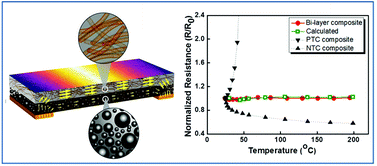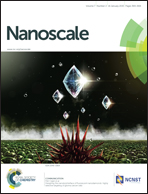Smart conducting polymer composites having zero temperature coefficient of resistance†
Abstract
Zero temperature coefficient of resistance (TCR) is essential for the precise control of temperature in heating element and sensor applications. Many studies have focused on developing zero-TCR systems with inorganic compounds; however, very few have dealt with developing zero-TCR systems with polymeric materials. Composite systems with a polymer matrix and a conducting filler show either a negative (NTC) or a positive temperature coefficient (PTC) of resistance, depending on several factors, e.g., the polymer nature and the filler shape. In this study, we developed a hybrid conducting zero-TCR composite having self-heating properties for thermal stability and reliable temperature control. The bi-layer composites consisted of a carbon nanotube (CNT)-based layer having an NTC of resistance and a carbon black (CB)-based layer having a PTC of resistance which was in direct contact with electrodes to stabilize the electrical resistance change during electric Joule heating. The composite showed nearly constant resistance values with less than 2% deviation of the normalized resistance until 200 °C. The CB layer worked both as a buffer and as a distributor layer against the current flow from an applied voltage. This behavior, which was confirmed both experimentally and theoretically, has been rarely reported for polymer-based composite systems.


 Please wait while we load your content...
Please wait while we load your content...